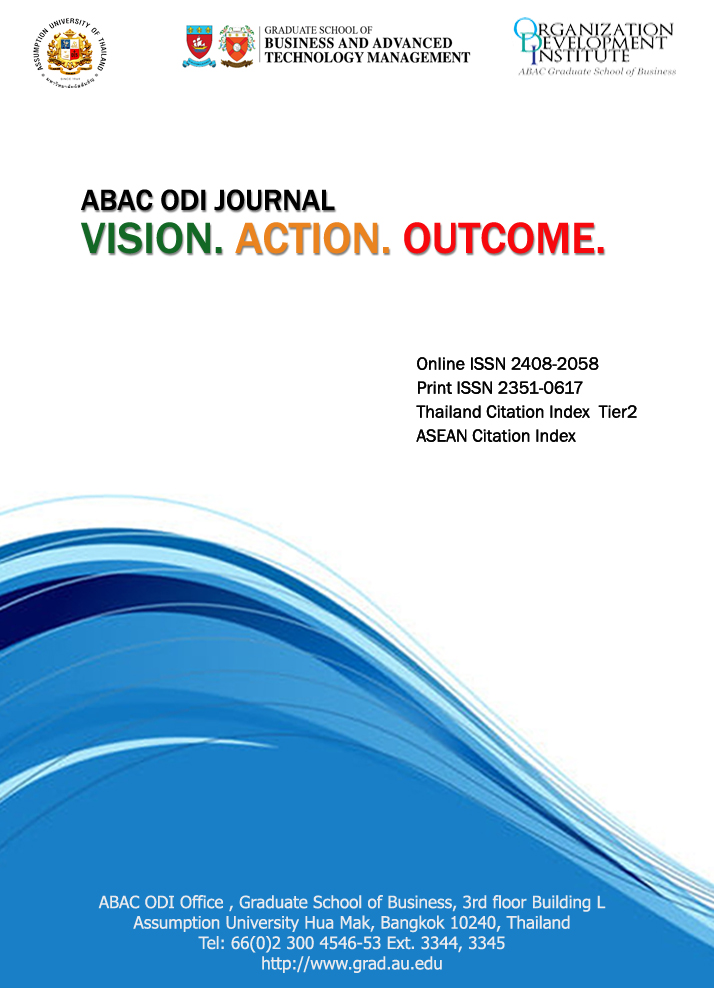Strategies to Improve Employees' Work Efficiency in One Brance of ABC Thai Restaurant
DOI:
https://doi.org/10.14456/abacodijournal.2021.13Keywords:
employee development, job satisfaction, leadership, teamwork, work efficiency, work environment.Abstract
This study focuses on determining the factors that influence work efficiency in a Thai Restaurant and aims to design strategies to improve employee work efficiency in the workplace. Mixed-method research using qualitative interviews and a quantitative questionnaire was utilized in this study. There were 12 interview respondents from the top management and middle management and 82 respondents for the questionnaire survey. Based on the qualitative analysis from inter-coding, the restaurant should give employees a clear goal and schedule to follow and choose a good leader to improve teamwork. The quantitative results from descriptive and inferential statistical analysis showed the organization needed to improve work efficiency by strengthening teamwork and employee development, such as teamwork training programs and employee development workshops.
References
Alshmemri, M., Shahwan-Akl, L., & Maude, P. (2017). Herzberg's Two-Factor Theory. Life Science Journal, 12-14.
Aswathappa, K., (2008) Human resource management: Text and cases. Tata McGraw-Hill Publishing Company Limited.
Chen, G., & Klimosi, R. J. (2007). Training and development of human resources at work: Is the state of our science strong? Human Resource Management.
Cooperrider, D.L. & Whitney, D (2001) A positive revolution in change. Appreciative Inquiry: An Emerging Direction for Organization Development.
Cravy, O.H. (2018). The Restaurant Industry- A Global Perspective. Medium.com. https://medium.com/@CravyHQ
De Grip, A., Sieben, I., Stevens, F. (2009), Are more competent workers more satisfied? Labour, 589‑607.
Heller, D., Judge, T.A. and Watson, D. (2002) 'The Confounding role of personality and trait affectivity in the relationship between job and life satisfaction', Journal of Organizational Behavior. 815–835.
Hussein, S., Moriarty, J., Stevens, M., Sharpe, E., Manthorpe, J. (2013), Organizational factors, job satisfaction and intention to leave among newly qualified social workers in England. Social Work Education.
Jacbos, R. & Washington, C., (2003). Employee development and organizational performance: A review of literature and directions for future research. Human Resource Development International.
June, M. (2002). How to Create Efficiency in the Workplace. Smallbusiness.chron.com.
https://smallbusiness.chron.com/create-efficiency-workplace-22333.html
Lipman, V. (2013). Why Employee Development Is Important, Neglected and Can Cost You Talent.
http://www.progress.org.pk/wp-content/uploads/2016/12/Why-Employee-Development-Is-Important.pdf
Ludema, J. & Hinrichs, G. (2003) Values‐based organization design: The case of John Deere Harvester Works. A.I. Practitioner.
Marks, M. A., Mathieu, J. E., & Zaccaro, S. J. (2001). A temporally based framework and taxonomy of team processes. Academy of Management Review. http://dx.doi.org/10.5465/amr.2001.4845785.
McCauley,C. D., & Hezlett, S. A., (2001). Individual development in workplace. Handbook of industrial work & organizational psychology. 313-315
Mohr, B.J., McLean, A. & Silbert, T. (2003). Beyond discovery & dream: Unleashing change through the design phase of an A.I. intervention. A.I. Practitioner.
Nahide, G. G., Maryam, G. G & Elshan, D. (2015) The effect of management factors and job satisfaction on human resources efficiency: A case study of paramedical employees of public hospitals in Ardabil. Industrial Management Institute.
Noe, R. A., Clark, A. D. M., & Klein, H. J. (2014). Learning in the twenty-century workplace. Annual Review of Organizational Psychology and Organizational Behavior
Oh, J. (2020). Transformational Leadership and Employee Turnover: A Longitudinal Study on the Effects of Collective Turnover. University of Guelph.
Sinha, D., Shukla, K.S. (2012), Comparative study of job satisfaction of the employees of private and public sector banks. Journal of Management.
Spector, P. (1997). Job satisfaction: Application, assessment, causes and consequences, Thousand Oaks, CA, Inc (Vol. 3). Sage Publications.
Stagl, K. C., Burke, C. S., Salas, E., & Pierce, L. (2006). Understanding adaptability: A prerequisite for effective performance within complex environments. The Netherlands.
Stello, C. M. (2011). Herzberg's two-factor theory of job satisfaction: An integrative literature review. Journal of Education and Human Development, 1-32.
Thailand - The Future of Foodservice to 2020. (2016). MarketResearch.com
https://www.marketresearch.com/GlobalData-v3648/Thailand-Future-Foodservice-11165456/
Thompson E.R. & Phua, T. (2012). A Brief Index of Affective Job Satisfaction, Journal of Business and Psychology.
Total sales value of full-service restaurants in Thailand from 2012 to 2019 (2020). Satista Research Department.
https://www.statista.com/statistics/870816/thailand-full-service-restaurants-total-sales/
Whitney, A. (2004). An Open Invitation to the Appreciative. A.I. Practitioner.
Working environment (2019). Personalenheten.
Yuexin, Z. (2019). Talking about improving work efficiency.



